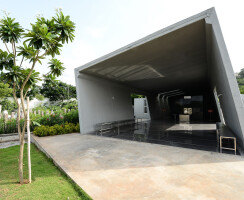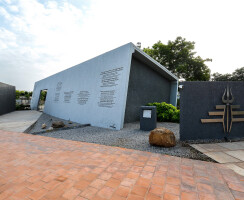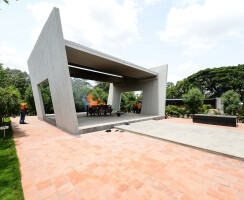Mahaprasthanam is a derivative of Mahāprasthānika Parva, Book 17 of the Mahabharata epic; it tells of how the five Paņdava brothers renounce the world and set out for mount Meru. Mahaprasthanam literally means “the great departure.”
The client, PHOENIX FOUNDATION along with Greater Hyderabad Municipal Corporation undertook the task of accomplishing this state of the art crematorium from a neglected stage. As an already existing 3.7 acre crematory/cemetery, the initiative was to modernize it so that it can accommodate the cultural and contextual modern needs of Hindu cremation rituals. A search for clarity, time constraints and impeccable order- being the modern outlook lead to picking up untouched land pockets amongst the graves, thereby leading to a scattering effect on the site. Yet, it is to an advantage as it supports the modernization in strategic laying along the functions for the Hindu rituals.
In Indian Philosophy, life’s purpose is fulfilled when one goes through the 16 phases called Shodasha Samskara, of this the final stage is the funeral ritual called Antyeșṭi. Antyeșṭi consists of five major stages; preparation of the body, cremation process, rites of mourning, purification for the family members, remembrance/mourning period. It is a belief that in the eternal search for truth and perfection, the action, duty or consequences are irrelevant. As an eventual rebirth, it is a solitary exploration that seeks perfection through birth and rebirth wherein the signification of life manifests through an unstoppable life-death cycle.
The project is a bodily extension of reverence, memory and of acceptance. It begins right at the entrance of the processional pathway with two stately walls inclined in a fashion of respect and revere of the dead. These precast concrete walls engraved with sacred Ģta scriptures hint upon the strength to behold the picturesque scenery of life ahead and the emotions left behind. These two walls stand as lone sentinels, guarding the dead. Raising above the ground to a height of 4 meters (on the shallow end) they direct ones eye towards the cremation pyres. Towards the left of these lone walls, in a cove of space is the Administrative block comprising of an office building, a book shop and, a locker room to with nearly 100 lockers to pay respects and store ashes. From a state of entropy the site was rejuvenated and restructured for an orchestrated procession of the Hindu funeral ritual. Every step is a reminder not of lost but of love as spirit of the loved lives on in many forms hence forth. Hence, designing spaces amongst existent crematory lead to scattered laying of built form. Cavumaedium of precast structures highlights the ritual and funeral procession as a linear and clear proceeding. The stately presence of a volume higher than life seemingly provides a comfort to the bereaved as more quite and acceptance comes with each step. Dynamic nature of the site dictate monolithic monuments reflecting its nature. After crossing the processional path under the entrance walls, a fallen concrete form catches the eye. The Electrical Pyre with its imported technology is one of its kind. The afore mentioned fallen form is not accidental but an intentionality of salutation to the dead. This form with its cavumaedium reminds one of the Chaitya Halls of the Buddist monks with their Stupa located along the line of the mountains. Entrance to the pyre is to the centre of the form which opens directly to the preparational pyre. The waiting hall has a capacity of 300-350 person overlooking the funeral ceremony and a provison to videographically record the ceremony is given. This N-S oriented building is one of the largest on the site with a height of 5 meters stands out prominently.
As one walks further along the processional pathway several other aspects of the site unfold themselves; serene landscaping, reminding scriptures and memories in graves. the natural funeral pyre is much elaborated due to its complex functionality, Lamenting the lost, the structures are shaped in such a way that; Waiting halls silently bow in honour, & Pyres open up to liberate the lost in a farewell. The pathway leads directly into the waiting hall which thereby leads to the pyre area. These two structures are separated due to the distribution of crowds ergo giving lucidity to the rituals undertaken in these spaces. Waiting halls can accommodate nearly 300 people while the pathway leading to the pyre is meant for the closest of the family members and the pyre is meant for the head of the family along with the priest who overlooks the ceremony.





























